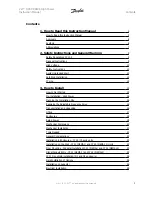
3.
Compare the two voltages.
4.
If the battery voltage and the controller voltage are not the same, then investigate why this is. Follow the path from the
controller to the battery to investigate what could be the cause.
Battery supply check
1.
Check and verify that all cabling is connected correctly, and that no wiring mistakes have been made.
2.
Check if all cable connections are tight while taking maximum torque levels into consideration.
3.
Check if all cable lugs or cable terminals have been crimped correctly.
4.
Check fuses and/or circuit breakers.
If a blown fuse is found, first ensure that the battery polarity has been correctly wired before replacing the
fuse. See next paragraph for more information on reverse battery polarity.
6.3.2. Reverse battery polarity
Reverse polarity is when the positive and the negative battery cable have been accidentally swapped. The battery negative has
been connected to the positive solar charger terminal and the battery positive has been connected to the negative solar charger
terminal.
Be aware that a red cable or positive labelled cable might not necessarily mean that the cable is indeed a
positive cable. A wiring or labelling mistake could have been made during installation of the solar charger.
The solar charger is not protected against reverse battery polarity and any damage caused by this is not covered under warranty.
Always verify the battery polarity before reconnecting the battery wires to the solar charger.
6.3.3. PV voltage too low
The solar charger will commence charging when the PV voltage is a minimum of 120V. Once charging has commenced, the PV
voltage must remain higher than 80V for charging to continue.
Check the PV and battery voltage
WARNING: Depending on the solar charge controller model, the PV voltage can be up to 450Vdc. Voltages
above 50V are generally considered to be dangerous. Check your local electrical safety regulations as to the
exact regulations. Dangerous voltages can only be handled by a qualified technician.
1.
Use the VictronConnect app, a solar charger display or a GX device to check the battery voltage and PV voltage.
2.
In case the above step is not possible, measure the battery and PV voltages at the solar charger terminals using a multi
meter instead.
3.
Compare both voltages. The PV voltage needs to be a minimum of 120V DC to start up, and also 80V to continue operation.
Causes of zero or low PV voltage:
Not enough solar irradiance into the solar panels:
• Night.
• Cloud cover or bad weather.
• Dirty panels.
• Seasonal differences.
• Wrong orientation and/or inclination.
Problems with a panel or panel wiring:
• Mechanical or electrical issue with an individual panel (or multiple panels).
Multi RS Solar
Page 24
Troubleshooting Guide - MPPT
















































